Israel launches ‘series of strikes’ into Gaza: Why, what’s happening with ceasefire plan
Israel Gaza strikes, Israel Hamas conflict 2025: Israeli strikes have returned to Gaza less than a week after ceasefire was declared. What led to this, and what has happened in Gaza in the past week?
 Israel Gaza strikes: An armed man shoots in the air during the funeral of Palestinians killed by Israeli fire, in Deir al-Balah, Gaza Strip, Sunday, Oct. 19, 2025. (AP Photo/Abdel Kareem Hana)
Israel Gaza strikes: An armed man shoots in the air during the funeral of Palestinians killed by Israeli fire, in Deir al-Balah, Gaza Strip, Sunday, Oct. 19, 2025. (AP Photo/Abdel Kareem Hana)Israel Gaza strikes: Less than a week after the grand Sharm El-Sheikh summit to mark the Israel-Hamas ‘peace’, Israel has launched a series of attacks on Gaza, in retaliation for ‘terrorists firing towards its troops’ in Rafah on Sunday (October 19). An Israeli security official said the transfer of humanitarian aid into Gaza is also being halted “until further notice”, AP reported.
“In response to the blatant violation of the ceasefire agreement earlier today, the IDF has begun a series of strikes against Hamas terror targets in the southern Gaza,” the official handle of the Israel Defence Forces (IDF) posted on X.
Hamas has said that it lost contact with groups operating in Rafah long ago, and has no information about Sunday’s events.
While there was no casualty on the Israeli side, at least nine Palestinians were killed, AP reported.
Israel’s Prime Minister, Benjamin Netanyahu said the military has been directed to “take strong action” against ceasefire breaches. While he did not threaten full resumption of war, “series of strikes” returning so soon to Gaza’s skies underline the fragility of the ceasefire yet again.
What happened on October 19?
According to the IDF, “terrorists fired an anti-tank missile and gunfire toward IDF troops operating to dismantle terrorist infrastructure in the Rafah area, in southern Gaza, in accordance with the ceasefire agreement. In response, the IDF has begun striking in the area to eliminate the threat and dismantle tunnel shafts and military structures used for terrorist activity.”
 Rafah is in the south of Gaza Strip, near the border with Egypt. (Photo: Wikimedia Commons)
Rafah is in the south of Gaza Strip, near the border with Egypt. (Photo: Wikimedia Commons)
, some 30 km from Gaza city. Hamas has said it has had no contact with its groups in Rafah for a while now.
Ever since the tenuous ceasefire came into effect about a week ago, both sides have accused each other of violations. Hamas has accused Israel of fomenting trouble within Gaza by arming ‘gangs’ and other undesirable elements.
Earlier on Sunday, the US had said it had reports that Hamas was planning to attack civilians in Gaza. Hamas had denied the claim.
What has happened in Gaza so far since the ceasefire?
Israel is yet to open the border crossing between Rafah and Egypt, which is vital for the flow of aid into Gaza and for Palestinians to move out to seek medical help. Israel has said it will open the border only after Hamas releases the remains of all hostages. All the hostages who were alive have been released.
Hamas says it is willing to release the remains, but needs special equipment to access them in a region that has turned to rubble under repeated bombing.
Meanwhile, Hamas seems to be reasserting control inside the Strip, and has carried out executions of alleged gangsters. The disarmament of Hamas is critical for the ceasefire to have any chance, and these executions have raised concerns among international observers.
US President Donald Trump earlier did not sound too perturbed by the killings, saying on October 14 that Hamas had taken out “a couple of gangs that were very bad”. “That didn’t bother me much, to be honest with you,” he said, as reported by AP. However, later into the week, he said if Hamas did not disarms themselves, they would be forced to do so.
How has the Gaza peace plan progressed so far?
Under the ceasefire, the IDF is supposed to withdraw from Gaza in phases, initially pulling back to a “yellow line”. Reuters has reported Defense Minister Israel Katz as saying that the yellow line will be physically marked and any attempt to cross the line will be met with fire.
 The map released by the White House showing the lines the IDF is supposed to withdraw to.
The map released by the White House showing the lines the IDF is supposed to withdraw to.
According to the plan, after the release of hostages and prisoners, “Hamas members who commit to peaceful co-existence and to decommission their weapons will be given amnesty. Members of Hamas who wish to leave Gaza will be provided safe passage to receiving countries.” Also, “full aid will be immediately sent into the Gaza Strip… including rehabilitation of infrastructure (water, electricity, sewage), rehabilitation of hospitals and bakeries, and entry of necessary equipment to remove rubble and open roads.”
There hasn’t been much progress on either point.
Hamas has not committed to disarming. Reuters quoted Hamas politburo member Mohammed Nazzal as saying that the group was ready for a ceasefire of up to five years to rebuild Gaza, with guarantees for what happens afterwards depending on Palestinians being given “horizons and hope” for statehood.
The later stages of the plan include a “temporary transitional governance of a technocratic, apolitical Palestinian committee” for Gaza, and the deployment of an International Stabilisation Force to take over from the IDF.



- 01
- 02
- 03
- 04
- 05



































